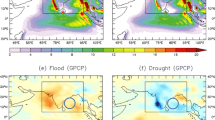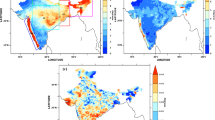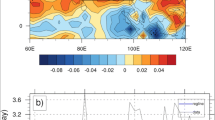Abstract
In this study, factors responsible for the deficit Indian Summer Monsoon (ISM) rainfall in 2014 and 2015 and the ability of Indian Institute of Tropical Meteorology-Global Ocean Data Assimilation System (IITM-GODAS) in representing the oceanic features are examined. IITM-GODAS has been used to provide initial conditions for seasonal forecast in India during 2014 and 2015. The years 2014 and 2015 witnessed deficit ISM rainfall but were evolved from two entirely different preconditions over Pacific. This raises concern over the present understanding of the role of Pacific Ocean on ISM variability. Analysis reveals that the mechanisms associated with the rainfall deficit over the Indian Subcontinent are different in the two years. It is found that remote forcing in summer of 2015 due to El Niño is mostly responsible for the deficit monsoon rainfall through changes in Walker circulation and large-scale subsidence. In the case of the summer of 2014, both local circulation with anomalous anticyclone over central India and intrusion of mid-latitude dry winds from north have contributed for the deficit rainfall. In addition to the above, Tropical Indian Ocean (TIO) sea surface temperature (SST) and remote forcing from Pacific Ocean also modulated the ISM rainfall. It is observed that Pacific SST warming has extended westward in 2014, making it a basin scale warming unlike the strong El Niño year 2015. The eastern equatorial Indian Ocean is anomalously warmer than west in summer of 2014, and vice versa in 2015. These differences in SST in both tropical Pacific and TIO have considerable impact on ISM rainfall in 2014 and 2015. The study reveals that initializing coupled forecast models with proper upper ocean temperature over the Indo-Pacific is therefore essential for improved model forecast. It is important to note that the IITM-GODAS which assimilates only array for real-time geostrophic oceanography (ARGO) temperature and salinity profiles could capture most of the observed surface and subsurface temperature variations from early spring to summer during the years 2014 and 2015 over the Indo-Pacific region. This study highlights the importance of maintaining observing systems such as ARGO for accurate monsoon forecast.










Similar content being viewed by others
References
Ananthakrishnan R (1970) Reversal of pressure gradients and wind circulation across India and the southwest monsoon. Quart J R Met Soc 96:539–542
Ashok K, Guan Z, Yamagata T (2001) Impact of the Indian Ocean dipole on the relationship between the Indian monsoon rainfall and ENSO. Geophys Res Lett 28(23):4499–4502
Balmaseda M, Anderson D (2009) Impact of initialization strategies and observations on seasonal forecast skill. Geophys Res Lett 36:L01701. doi:10.1029/2008GL035561
Balmaseda M, Anderson D, Vidard A (2007) Impact of ARGO on analyses of the global ocean. Geophys Res Lett 34:L16605. doi:10.1029/2007GL030452
Balmaseda MA, Alves OJ, Arribas A, Awaji T, Behringer DW, Ferry N, Fujii Y, Lee T, Rienecker M, Rosati T, Stammer D (2009) Ocean initialization for seasonal forecasts. Oceanography 22(3):154–159. doi:10.5670/oceanog.2009.73
Bawiskar SM (2009) Weakening of lower tropospheric temperature gradient between Indian landmass and neighbouring oceans and its impact on Indian monsoon. J Earth Syst Sci 118(4):273–280
Behringer DW (2007) The Global Ocean Data Assimilation System at NCEP, paper presented at the 11th Symposium on Integrated Observing and Assimilation Systems for Atmosphere, Oceans, and Land Surface, Am. Meteorol. Soc., San Antonio, Tex
Behringer DW, Xue Y (2004) Evaluation of the global ocean data assimilation system at NCEP: the Pacific Ocean. Eighth symposium on integrated observing and assimilation system for atmosphere, ocean, and land surface, AMS 84th annual meeting, 11–15
Chowdary JS, Bandgar AB, Gnanaseelan C, Luo J-J (2015) Role of tropical Indian Ocean air–sea interactions in modulating Indian summer monsoon in a coupled model. Atmos Sci Let 16:170–176. doi:10.1002/asl2.561
Dee DP, Uppala SM, Simmons AJ, Berrisford P, Poli P, Kobayashi S, Andrae U, Balmaseda MA, Balsamo G, Bauer P, Bechtold P, Beljaars ACM, van de Berg L, Bidlot J, Bormann N, Delsol C, Dragani R, Fuentes M, Geer AJ, Haimberger L, Healy SB, Hersbach H, Holm EV, Isaksen L, Kallberg P, Kohler M, Matricardi M, McNally AP, Monge-Sanz BM, Morcrette J-J, Park B-K, Peubey C, de Rosnay P, Tavolato C, Thepaut J-N, Vitart F (2011) The ERA-interim reanalysis: configuration and performance of the data assimilation system. Q J R Meteorol Soc 137:553–597
Gadgil S, Vinayachandran PN, Francis PA, Gadgil S (2004) Extremes of the Indian summer monsoon rainfall, ENSO and equatorial Indian Ocean oscillation. Geophys Res Lett 31:L12213. doi:10.1029/2004GL019733
Gadgil S, Rajeevan M, Francis PA (2007) Monsoon variability: links to major oscillations over the equatorial Pacific and Indian oceans. Current Science Special Section: Indian Monsoon 93(2):182–194
Good SA, Martin MJ, Rayner NA (2013) EN4: quality controlled ocean temperature and salinity profiles and monthly objective analyses with uncertainty estimates. J Geophys Res: Oceans 118:6704–6716. doi:10.1002/2013JC009067
Goswami BN, Krishnamurthy V, Annamalai H (1999) A broadscale circulation index for interannual variability of the Indian summer monsoon. Q J R Meteorol Soc 125:611–633
Gould J, Roemmich D, Wijffels S, Freeland H, Ignaszewsky M, Jianping X, Pouliquen S, Desaubies Y, Send U, Radhakrishnan K, Takeuchi K, Kim K, Danchenkov M, Sutton P, King B, Owens B, Riser S (2004) ARGO profiling floats bring new era of in Situ Ocean observations. Eos 85(19):185–191. doi:10.1029/2004EO190002
Griffies SM, Harrison MJ, Pacanowski RC, Rosati A (2004) A technical guide to MOM4. NOAA/Geophysical Fluid Dynamics Laboratory, Princeton, USA, 337 pp
Harrison DE, Vecchi GA (2001) El Niño and La Niña—equatorial Pacific thermocline depth and sea surface temperature anomalies, 1986-98. Geophys Res Lett 28(6):1051–1054
Hu S, Fedorov AV (2016) Exceptionally strong easterly wind burst stalling el Niño of 2014. Proc Natl Acad Sci U S A 113(8):2005–2010
Ji M, Leetmaa A (1997) Impact of data assimilation on ocean initialization and El Niño prediction. Mon Weath Rev 125:742:753
Ji M, Behringer W, Leetmaa A (1998) An improved coupled model for ENSO prediction and implications for ocean initialization. Part II: the coupled model. Mon Weath Rev 126:1022–1034
Jiang X, Yang S, Li Y, Kumar A, Liu X, Zuo Z, Zha B (2013) Seasonal-to-interannual prediction of the Asian summer monsoon in the NCEP climate forecast system version 2. J Clim 26:3708–3727. doi:10.1175/JCLI-D-12-00437.1
Keshavamurthy RN (1982) Response of the atmosphere to sea surface temperature anomalies over the equatorial Pacific and the teleconnections of the southern oscillation. J Atmos Sci 39:1241–1259
Khandekar R, Gnanaseelan C, Swapna P, Parekh A, Sreenivas P, Srinivas G, Chowdary JS, Deepa JS (2015) Oceanic features in the Indo-Pacific region during the southwest monsoon 2015. In: Mujumdar M, Gnanaseelan C, Rajeevan M (eds) A Research Report on the 2015 Southwest Monsoon. IITM Scientific (Research) Report, pp14–22, ISSN 0252–1075, ESSO/IITM/ SERP/SR/02(2015)/185
Kim H-M, Webster PJ, Curry JA, Toma VE (2012) Asian summer monsoon prediction in ECMWF system 4 and NCEP CFSv2 retrospective seasonal forecasts. Clim Dyn 39:2975–2991. doi:10.1007/s00382-012-1470-5
Kothawale DR, Kulkarni JR (2014) Performance of all-India southwest monsoon seasonal rainfall when monthly rainfall reported as deficit/excess. Meteorol Appl 21:619–634. doi:10.1002/met.1385
Kothawale DR, Munot AA, Borgaonkar HP (2008) Temperature variability over the Indian Ocean and its relationship with Indian summer monsoon rainfall. Theor. Appl Climatol 92:31–35. doi:10.1007/s00704-006-0291-z
Kripalani RH, Kulkarni A (1997) Climatic impact of El-Niño/La Niña on the Indian monsoon: a new perspective. Weather 52:39–46
Krishnan R, Ramesh KV, Samala BK, Meyers G, Slingo JM, Fennessy MJ (2006) Indian Ocean-monsoon coupled interactions and impending monsoon droughts. Geophys Res Lett 33:L08711. doi:10.1029/2006GL025811
Kug J-S, Choi J, An S-I, Jin F-F, Wittenberg AT (2010) Warm pool and cold tongue El Niño events as simulated by the GFDL 2.1 coupled GCM. J Clim 23:1226–1239. doi:10.1175/2009JCLI3293.1
Kumar KK, Rajagopalan KB, Cane MA (1999) On the weakening relationship between the Indian monsoon and ENSO. Science 284:2156–2159
Kumar KK, Rajagopalan B, Hoerling M, Bates G, Cane M (2006) Unraveling the mystery of Indian monsoon failure during El Niño. Science 314:115–119. doi:10.1126/science.1131152
Lee H-T and NOAA CDR Program (2011): NOAA climate data record (CDR) of monthly outgoing longwave radiation (OLR), Version 2.2–1. NOAA National Climatic Data Center. doi:10.7289/V5222RQP
Levine AFZ, McPhaden MJ (2016) How the July 2014 easterly wind burst gave the 2015-2016 El Niño a head start. Geophys Res Lett 43:6503–6510. doi:10.1002/2016GL069204
Levitus S, Antonov JI, Boyer TP, Locarnini RA, Garcia HE, Mishonov AV (2009) Global ocean heat content 1955-2008 in light of recently revealed instrumentation problems. Geophy Res Lett 36:L07608. doi:10.1029/2008GL037155
Pai DS, Bhan SC (2015) Monsoon 2014: a report. IMD Met. Monograph: ESSO Document No.: ESSO/IMD/Synoptic Met./01(2015)/17
Pai DS, Sridhar L, Rajeevan M, Sreejith OP, Satbhai NS, Mukhopadhyay B (2014) Development of a new high spatial resolution (0.25° × 0.25°) long period (1901-2010) daily gridded rainfall data set over India and its comparison with existing data sets over the region. Mausam 65(1):1–18
Pant GB, Parthasarathy B (1981) Some aspects of an association between the southern oscillation and Indian summer monsoon. A Met Geophy Biokl Ser B 29:245–251
Rasmusson EM, Carpenter TH (1983) The relationship between eastern equatorial Pacific Sea surface temperature and rainfall over India and Sri Lanka. Mon Weather Rev 111:517–528
Ravichandran M, Behringer D, Sivareddy S, Girishkumar MS, Neethu C, Harikumar R (2011) INCOIS-GODAS-MOM: ocean analysis for the Indian Ocean: configuration, validation and product dissemination. Technical Report Report No.: INCOIS-MOG-TR-2011-06
Ravichandran M, Behringer D, Sivareddy S, Girishkumar MS, Chacko N, Harikumar R (2013) Evaluation of the Global Ocean data assimilation system at INCOIS: the tropical Indian Ocean. Ocean Model 69:123–135
Reynolds RW, Smith TM, Liu C, Chelton DB, Casey KS, Schlax MG (2007) Daily high-resolution-blended analyses for sea surface temperature. J Clim 20:5473–5496. doi:10.1175/2007JCLI1824.1
Roemmich D, Gilson J (2009) The 2004–2008 mean and annual cycle of temperature, salinity, and steric height in the global ocean from the ARGO program. Prog Oceanogr 82:81–100. doi:10.1016/j.pocean.2009.03.004
Roemmich D, Gilson J (2011) The global ocean imprint of ENSO. Geophys Res Lett 38:L13606. doi:10.1029/2011GL047992
Roemmich D et al. (the Argo Science Team) (1998) On the design and implementation of ARGO: an initial plan for a global array of profiling floats. International CLIVAR Project Office Report 21, GODAE International Project Office, Melbourne, Australia, 32 pp
Ropelewski CP, Halpert MS (1987) Global and regional scale precipitation patterns associated with the El Niño/southern oscillation. Mon Weather Rev 115:1606–1626
Saha S, Moorthi S,Wu X,Wang J, Nadiga S, Tripp P, Behringer D, Hou Y-T, Chuang H, Iredell M, Ek M, Meng J, Yang R, MendezMP, Dool HVD, ZhangQ,WangW, ChenM, Becker E (2014) The NCEP climate forecast system version 2. J Clim 27: 2185–2208
Saha SK, Pokhrel S, Salunke K, Dhakate A, Chaudhari HS, Rahaman H, Sujith K, Hazra A, Sikka DR (2016) Potential predictability of Indian summer monsoon rainfall in NCEP CFSv2. J Adv Model Earth Syst 8:96–120. doi:10.1002/2015MS000542
Saji NH, Goswami BN, Vinayachandran PN, Yamagata T (1999) A dipole mode in the tropical Indian Ocean. Nature 401:360–363
Shukla J (1975) Effect of Arabian Sea-surface temperature anomaly on Indian summer monsoon: a numerical experiment with the GFDL model. J Atmos Sci 32:503–511
Sreenivas P, Gnanaseelan C, Kakatkar R, Pavan Kumar N, Chowdary JS, Parekh A, Singh P (2015) Implementation and validation of Global Ocean Data Assimilation System at IITM. IITM Scientific (Research) Report, ISSN 0252–1075, ESSO/IITM/SERP/SR/01(2015)/184
Trenberth KE, Hurrell JW, Stepaniak DP (2006) The Asian Monsoon: global perspectives. In: Wang B (ed) The Asian Monsoon. Springer, Praxis Publishing Ltd., UK, pp 67–87
Varikoden H, Singh BB, Sooraj KP, Joshi MK, Preethi B, Mujumdar M, Rajeevan M., (2015), Large scale features of southwest monsoon during 2015. In: Mujumdar M, Gnanaseelan C, Rajeevan M (ed) A Research Report on the 2015 Southwest Monsoon. IITM Scientific (Research) Report, pp 2–13, ISSN 0252–1075, ESSO/IITM/ SERP/SR/02(2015)/185
Vecchi GA, Harrison DE (2000) Tropical Pacific Sea surface temperature anomalies, El Niño, and equatorial westerly wind events. J Clim 13:1814–1830
Webster PJ (2006) The coupled monsoon system. In: Wang B (ed) The Asian Monsoon. Springer, Praxis Publishing Ltd., UK, pp 3–66
Webster PJ, Chou LC (1980) Seasonal structure of a simple monsoon system. J Atms Sci 37:354–367
Webster PJ, Magana VO, Palmer TN, Shukla J, Tomas RA, Yanai M, Yasunari T (1998) Monsoons: processes, predictability, and the prospects for prediction. J Geophys Res 103(C7):14451–14510
Xie P, Arkin PA (1997) Global precipitation: a 17-year monthly analysis based on gauge observations, satellite estimates, and numerical model outputs. Bull Amer Meteor Soc 78:2539–2558
Yang S, Zhang Z, Kousky VE, Higgins RW, Yoo S-H, Liang J, Fan Y (2008) Simulations and seasonal prediction of the Asian summer monsoon in the NCEP climate forecast system. J Clim 21:3755–3775. doi:10.1175/2008JCLI1961.1
Zelle H, Appeldoorn G, Burgers G, Oldenborgh GJV (2004) The relationship between sea surface temperature and thermocline depth in the eastern equatorial Pacific. J Phys Oceanogr 34:643–655
Acknowledgements
We acknowledge Director, ESSO-IITM for the support. CMAP precipitation data and NOAA high-resolution SST data is made available by the NOAA/OAR/ESRL PSD, Boulder, Colorado, USA, in their Web site at http://www.esrl.noaa.gov/psd/. We acknowledge NCMRWF for forcing data and Coriolis for ARGO data. The Had-EN4 data is available through http://www.metoffice.gov.uk/hadobs/en4/download-en4-1-1.html. Initial conditions for CFSv2 are obtained from NCEP. We acknowledge R. Phani, Raju Mandal, P. Sreenivas and R.H. Kripalani for scientific discussion. Figures are prepared using PyFerret, grads and Origin.
Author information
Authors and Affiliations
Corresponding author
Rights and permissions
About this article
Cite this article
Kakatkar, R., Gnanaseelan, C., Chowdary, J.S. et al. Indian summer monsoon rainfall variability during 2014 and 2015 and associated Indo-Pacific upper ocean temperature patterns. Theor Appl Climatol 131, 1235–1247 (2018). https://doi.org/10.1007/s00704-017-2046-4
Received:
Accepted:
Published:
Issue Date:
DOI: https://doi.org/10.1007/s00704-017-2046-4




